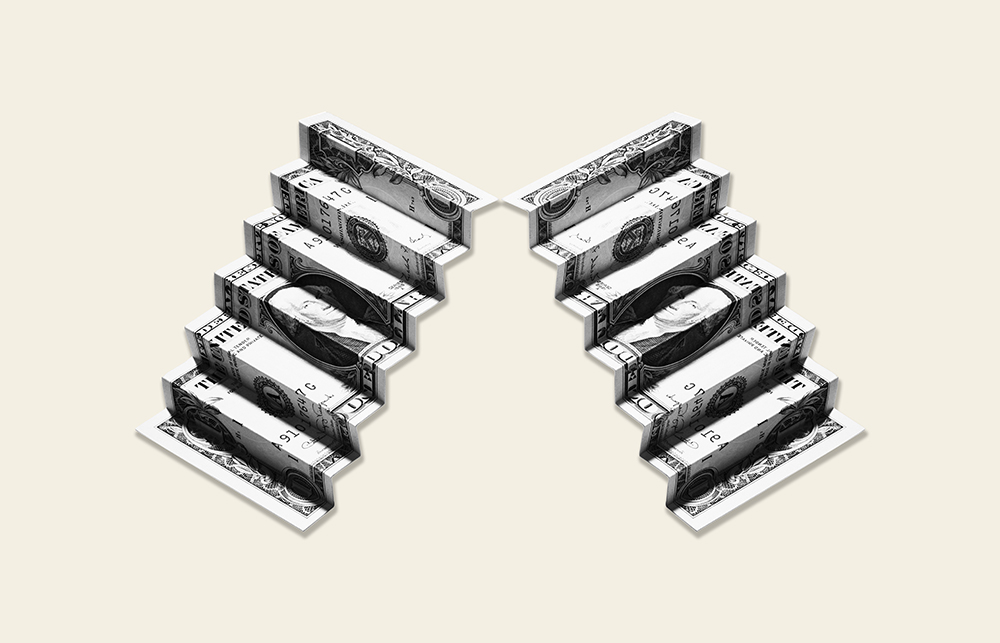
過(guò)去一年,白宮之爭(zhēng),、美國(guó)參議院控制權(quán)之戰(zhàn)和新冠疫情造成的破壞占據(jù)了各大媒體的頭版頭條,。然而,一項(xiàng)巨大的財(cái)政困境卻很大程度上避開了公眾的監(jiān)督:聯(lián)邦政府越來(lái)越難以為它所做的和想做的一切提供資金,。
即使遭到新冠疫情破壞的經(jīng)濟(jì)已開始復(fù)蘇,,聯(lián)邦政府的平均年度預(yù)算赤字也將達(dá)到2萬(wàn)億美元,相當(dāng)于總稅收收入的40%,。在政治壓力的推動(dòng)下,,政府開支將進(jìn)一步走高,而中產(chǎn)階級(jí)的稅收將進(jìn)一步降低,。新任總統(tǒng)拜登曾表示,,他計(jì)劃提高對(duì)高收入階層的稅收,但共和黨肯定會(huì)反對(duì),。
其實(shí),,有一項(xiàng)切實(shí)可行的解決方案,可以在不引發(fā)兩黨爭(zhēng)執(zhí)的情況下解決這一困境:追查逃稅,。2019年,,美國(guó)納稅人逃稅的金額高達(dá)5740億美元,,比收入后90%的個(gè)人納稅人所支付的稅款總額還要多。如果我們僅僅只增加稅收,,而不修補(bǔ)稅收系統(tǒng)的漏洞,,那么只有已經(jīng)依法納稅的納稅人會(huì)承擔(dān)增稅的壓力。
這既不公平,,也不利于維系稅收系統(tǒng),。
追查逃稅可以讓稅收工作更公平、更容易,,還能在未來(lái)十年里為聯(lián)邦政府增加1.4萬(wàn)億美元的收入,,而且其中大部分都來(lái)自未繳納一分一厘應(yīng)繳稅款的高收入人群。這一金額超過(guò)了拜登提出的提高個(gè)人所得稅計(jì)劃,。聯(lián)邦政府加強(qiáng)稅收合規(guī)的舉措也會(huì)帶動(dòng)州政府、地方政府的收入增加,。
我們追查逃稅的計(jì)劃包括三個(gè)部分:改善美國(guó)國(guó)稅局的信息收集方式,,開發(fā)技術(shù)幫助國(guó)稅局充分利用收集到的信息,增加針對(duì)高收入納稅人的檢查,。
大多數(shù)納稅人不需要接受審計(jì),,因?yàn)樗麄儠?huì)收到雇主提供的W-2表、銀行提供的1099表或其他報(bào)表,。這些信息可以幫助納稅人準(zhǔn)確報(bào)稅,,同時(shí)方便國(guó)稅局切實(shí)檢查合規(guī)情況。雇主和銀行申報(bào)的收入中95%得到了納稅人的正確申報(bào),,但第三方機(jī)構(gòu)申報(bào)的收入(如大多數(shù)業(yè)務(wù)收入)中只有45%被申報(bào)納稅,。此外,美國(guó)有一種將公司收入視為個(gè)人收入的企業(yè)(pass-through business,,部分為合伙制),,此類企業(yè)產(chǎn)生的總收入高達(dá)1萬(wàn)億美元,但卻往往是稅收系統(tǒng)的漏網(wǎng)之魚,,缺乏第三方申報(bào),,審計(jì)率幾近于零。
我們可以修補(bǔ)第三方向國(guó)稅局申報(bào)各種收入時(shí)存在的漏洞,,用一種高效的方式大幅加強(qiáng)納稅人和國(guó)稅局的合規(guī)性,。
獨(dú)立監(jiān)察機(jī)構(gòu)近期的報(bào)告支持了這一結(jié)論。美國(guó)財(cái)政部稅務(wù)管理監(jiān)察長(zhǎng)和政府問(wèn)責(zé)局已經(jīng)表明,,政府可以通過(guò)更有效地利用第三方申報(bào),,向高收入納稅人征收數(shù)十億美元。一份報(bào)告顯示,,幾百名欠稅高達(dá)100億美元但未提交納稅申報(bào)表的納稅人甚至沒(méi)有受到國(guó)稅局的追究,。
更新國(guó)稅局過(guò)時(shí)的技術(shù)將有助于國(guó)稅局利用一切可用信息,,更準(zhǔn)確地快速評(píng)估所有納稅申報(bào)表,找出其中的缺漏,,并提高審計(jì)工作的效率,。
我們提出的技術(shù)更新計(jì)劃也有利于國(guó)稅局借助更快速、更便捷的通信方式提高服務(wù)質(zhì)量,。如果此前做好技術(shù)能力建設(shè),,聯(lián)邦政府本可以更有效地落實(shí)新冠疫情救助措施,包括現(xiàn)金分發(fā)和小型企業(yè)貸款,。
我們的計(jì)劃將創(chuàng)造一個(gè)更加精簡(jiǎn),、重點(diǎn)更明確的執(zhí)行過(guò)程。如今,,有錢人和受到審計(jì)的納稅人大相徑庭,。假設(shè)一個(gè)人住在密西西比河三角洲、收入2.5萬(wàn)美元,,而另一個(gè)人住在紐約公園大道,、收入幾百萬(wàn)美元,那么前者受到國(guó)稅局審計(jì)的概率將會(huì)大于后者,。
我們的計(jì)劃一開始的確會(huì)增加政府開支,,但隨著時(shí)間的推移,它將帶來(lái)相當(dāng)于成本15至20倍的收入,,同時(shí)提高稅收系統(tǒng)的公平性和可持續(xù)性,。
聯(lián)邦預(yù)算調(diào)整工作即將開始,我們可以抓住這個(gè)絕佳的機(jī)會(huì),,為國(guó)稅局提供追查逃稅所需的方向和資源,,包括增加技術(shù)改善、人員任用經(jīng)費(fèi)和預(yù)估未來(lái)十年有望增加的相關(guān)收入,。
拜登強(qiáng)調(diào),,兩黨應(yīng)合作解決問(wèn)題。按照我們的提議修補(bǔ)稅收系統(tǒng)的漏洞,,將有助于聯(lián)邦政府著手解決當(dāng)下面臨的最大困境之一,。(財(cái)富中文網(wǎng))
弗雷德?戈德堡(Fred Goldberg)曾在老布什執(zhí)政期間擔(dān)任美國(guó)國(guó)稅局局長(zhǎng)。
查爾斯?羅薩提(Charles Rossotti)曾在比爾?克林頓和老布什執(zhí)政期間擔(dān)任美國(guó)國(guó)稅局局長(zhǎng),。
譯者:錢功毅
目前美國(guó)存在大量逃稅,,而且其中大部分都是高收入人群本應(yīng)繳納的稅款。圖片版權(quán):大衛(wèi)?亞奇(David Arky),,蓋蒂圖片社
過(guò)去一年,,白宮之爭(zhēng)、美國(guó)參議院控制權(quán)之戰(zhàn)和新冠疫情造成的破壞占據(jù)了各大媒體的頭版頭條,。然而,,一項(xiàng)巨大的財(cái)政困境卻很大程度上避開了公眾的監(jiān)督:聯(lián)邦政府越來(lái)越難以為它所做的和想做的一切提供資金,。
即使遭到新冠疫情破壞的經(jīng)濟(jì)已開始復(fù)蘇,聯(lián)邦政府的平均年度預(yù)算赤字也將達(dá)到2萬(wàn)億美元,,相當(dāng)于總稅收收入的40%,。在政治壓力的推動(dòng)下,政府開支將進(jìn)一步走高,,而中產(chǎn)階級(jí)的稅收將進(jìn)一步降低,。新任總統(tǒng)拜登曾表示,他計(jì)劃提高對(duì)高收入階層的稅收,,但共和黨肯定會(huì)反對(duì),。
其實(shí),有一項(xiàng)切實(shí)可行的解決方案,,可以在不引發(fā)兩黨爭(zhēng)執(zhí)的情況下解決這一困境:追查逃稅,。2019年,美國(guó)納稅人逃稅的金額高達(dá)5740億美元,,比收入后90%的個(gè)人納稅人所支付的稅款總額還要多,。如果我們僅僅只增加稅收,而不修補(bǔ)稅收系統(tǒng)的漏洞,,那么只有已經(jīng)依法納稅的納稅人會(huì)承擔(dān)增稅的壓力,。
這既不公平,,也不利于維系稅收系統(tǒng),。
追查逃稅可以讓稅收工作更公平、更容易,,還能在未來(lái)十年里為聯(lián)邦政府增加1.4萬(wàn)億美元的收入,,而且其中大部分都來(lái)自未繳納一分一厘應(yīng)繳稅款的高收入人群。這一金額超過(guò)了拜登提出的提高個(gè)人所得稅計(jì)劃,。聯(lián)邦政府加強(qiáng)稅收合規(guī)的舉措也會(huì)帶動(dòng)州政府,、地方政府的收入增加。
我們追查逃稅的計(jì)劃包括三個(gè)部分:改善美國(guó)國(guó)稅局的信息收集方式,,開發(fā)技術(shù)幫助國(guó)稅局充分利用收集到的信息,,增加針對(duì)高收入納稅人的檢查。
大多數(shù)納稅人不需要接受審計(jì),,因?yàn)樗麄儠?huì)收到雇主提供的W-2表,、銀行提供的1099表或其他報(bào)表。這些信息可以幫助納稅人準(zhǔn)確報(bào)稅,,同時(shí)方便國(guó)稅局切實(shí)檢查合規(guī)情況。雇主和銀行申報(bào)的收入中95%得到了納稅人的正確申報(bào),,但第三方機(jī)構(gòu)申報(bào)的收入(如大多數(shù)業(yè)務(wù)收入)中只有45%被申報(bào)納稅,。此外,,美國(guó)有一種將公司收入視為個(gè)人收入的企業(yè)(pass-through business,,部分為合伙制),,此類企業(yè)產(chǎn)生的總收入高達(dá)1萬(wàn)億美元,但卻往往是稅收系統(tǒng)的漏網(wǎng)之魚,,缺乏第三方申報(bào),,審計(jì)率幾近于零,。
我們可以修補(bǔ)第三方向國(guó)稅局申報(bào)各種收入時(shí)存在的漏洞,,用一種高效的方式大幅加強(qiáng)納稅人和國(guó)稅局的合規(guī)性。
獨(dú)立監(jiān)察機(jī)構(gòu)近期的報(bào)告支持了這一結(jié)論,。美國(guó)財(cái)政部稅務(wù)管理監(jiān)察長(zhǎng)和政府問(wèn)責(zé)局已經(jīng)表明,,政府可以通過(guò)更有效地利用第三方申報(bào),,向高收入納稅人征收數(shù)十億美元,。一份報(bào)告顯示,,幾百名欠稅高達(dá)100億美元但未提交納稅申報(bào)表的納稅人甚至沒(méi)有受到國(guó)稅局的追究。
更新國(guó)稅局過(guò)時(shí)的技術(shù)將有助于國(guó)稅局利用一切可用信息,更準(zhǔn)確地快速評(píng)估所有納稅申報(bào)表,,找出其中的缺漏,,并提高審計(jì)工作的效率,。
我們提出的技術(shù)更新計(jì)劃也有利于國(guó)稅局借助更快速,、更便捷的通信方式提高服務(wù)質(zhì)量,。如果此前做好技術(shù)能力建設(shè),,聯(lián)邦政府本可以更有效地落實(shí)新冠疫情救助措施,,包括現(xiàn)金分發(fā)和小型企業(yè)貸款,。
我們的計(jì)劃將創(chuàng)造一個(gè)更加精簡(jiǎn),、重點(diǎn)更明確的執(zhí)行過(guò)程,。如今,,有錢人和受到審計(jì)的納稅人大相徑庭。假設(shè)一個(gè)人住在密西西比河三角洲、收入2.5萬(wàn)美元,,而另一個(gè)人住在紐約公園大道、收入幾百萬(wàn)美元,,那么前者受到國(guó)稅局審計(jì)的概率將會(huì)大于后者,。
我們的計(jì)劃一開始的確會(huì)增加政府開支,,但隨著時(shí)間的推移,它將帶來(lái)相當(dāng)于成本15至20倍的收入,,同時(shí)提高稅收系統(tǒng)的公平性和可持續(xù)性,。
聯(lián)邦預(yù)算調(diào)整工作即將開始,,我們可以抓住這個(gè)絕佳的機(jī)會(huì),,為國(guó)稅局提供追查逃稅所需的方向和資源,,包括增加技術(shù)改善,、人員任用經(jīng)費(fèi)和預(yù)估未來(lái)十年有望增加的相關(guān)收入,。
拜登強(qiáng)調(diào),兩黨應(yīng)合作解決問(wèn)題,。按照我們的提議修補(bǔ)稅收系統(tǒng)的漏洞,,將有助于聯(lián)邦政府著手解決當(dāng)下面臨的最大困境之一。(財(cái)富中文網(wǎng))
弗雷德?戈德堡(Fred Goldberg)曾在老布什執(zhí)政期間擔(dān)任美國(guó)國(guó)稅局局長(zhǎng),。
查爾斯?羅薩提(Charles Rossotti)曾在比爾?克林頓和老布什執(zhí)政期間擔(dān)任美國(guó)國(guó)稅局局長(zhǎng),。
譯者:錢功毅
The battle for the White House, control of the U.S. Senate, and the devastation caused by the COVID-19 pandemic have dominated headlines for a year. But a giant financial dilemma—the federal government’s rising inability to pay for everything it does and wants to do—has largely skirted public scrutiny.
Even when the economy recovers from the COVID-19 crisis, annual budget deficits will average about $2 trillion per year, equal to 40% of all tax revenue. Political pressures will push spending up and taxes down for the middle class. Meanwhile, candidate Biden said he was going to raise taxes on the upper-income brackets, which Republicans will surely oppose.
There is a practical, bipartisan solution to this dilemma: shrinking the tax gap. In 2019 the tax gap—taxes owed but not paid—was $574 billion. That’s more than all the taxes paid by the lowest 90% of individual taxpayers. If we simply raise taxes without also fixing the system, only taxpayers who are already compliant will bear the increase.
That is not fair or sustainable.
Closing the tax gap will make tax collection fairer and easier for people while collecting an additional $1.4 trillion over 10 years—mostly from people in the upper brackets who don’t pay all the taxes they owe. This amount is more than President Biden’s plan to raise individual income taxes. Increased compliance at the federal level also translates to increased revenue at the state and local level.
Our plan to close the tax gap comprises three parts: better information collection by the IRS, technology that enables the IRS to make full use of the information it collects, and increased examinations directed at high-income individuals.
Most taxpayers don’t need to be audited because they receive reports such as W-2s from their employers or 1099s from their banks. This information helps taxpayers file accurately and allows the IRS to check compliance efficiently. About 95% of income that is reported by employers and banks is accurately reported by taxpayers, but only 45% of income that is not reported by third parties, such as most business income, is reported and taxed. This lack of visibility is also true of $1 trillion of income produced in pass-through businesses, such as partnerships, where there is no third-party reporting and the audit rate is negligible.
By filling the holes in the kinds of income reported by third parties to the IRS, we can greatly increase compliance in an efficient way for both taxpayers and the IRS.
Recent reports by independent watchdogs have supported this conclusion. The Treasury Inspector General for Tax Administration and the Government Accountability Office have shown that many billions could be collected from upper-income taxpayers through more effective use of third-party reporting. One report showed that a few hundred taxpayers who owed $10 billion and failed to file a return were not even pursued by the IRS.
Updating the IRS’s outdated technology would enable rapid assessment of all tax returns using all available information to identify deficiencies with much greater accuracy, and would improve the efficiency of the audit process.
The technology we are proposing would also improve the IRS’s quality of service through faster and more convenient methods of communication. This capacity-building would have permitted far more effective implementation of COVID relief responses, ranging from cash distributions to small business loans.
Our plan would create a more streamlined and focused enforcement process. Today, the disparity between who has money and who is audited is egregious. If you live in the Mississippi Delta and your income is $25,000, you are more likely to be audited by the IRS than if you live on New York’s Park Avenue and make millions.
Yes, our plan would require increased spending, but over time it would produce revenue equal to 15 to 20 times its cost while increasing the fairness and sustainability of the tax system.
The upcoming federal budget reconciliation process is a prime opportunity to provide the direction and resources the IRS needs to shrink the tax gap, including outlays for increased technology and staffing, as well as estimates related to revenue gains over the next 10 years.
Biden has emphasized a bipartisan approach to solving problems. Fixing the tax system as we propose would be a great start toward resolving one of the government’s most difficult dilemmas.
Fred Goldberg served as IRS commissioner in the George H.W. Bush administration.
Charles Rossotti served as IRS commissioner in the Bill Clinton and George W. Bush administrations.






